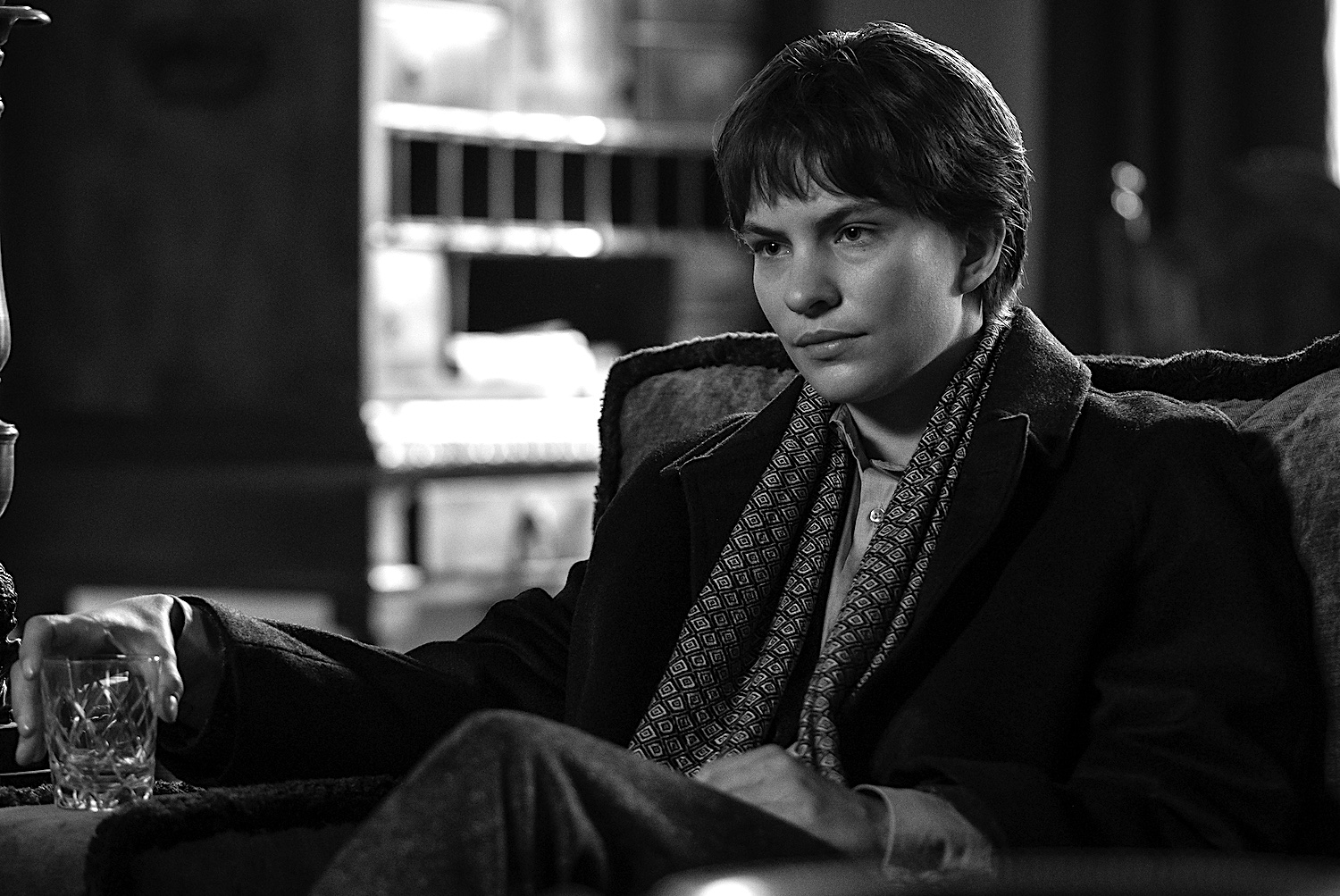There would have to be a good reason for making another screen version of Patricia Highsmith’s 1955 novel The Talented Mr Ripley, already successfully adapted by Anthony Minghella in his 1999 film.
One this new adaptation presumably had in mind was creating an even more in-depth portrait of Tom Ripley, played by Andrew Scott, over eight 50-minute episodes. It’s also a change of pace visually, shot in moody black and white, though updated to 1961. Netflix’s resources are on full show, notably in its writer-director Steve Zaillian (Moneyball, The Irishman, The Night Of) and his Oscar-winning DP, Robert Elswit. But the credits for all aspects of the visuals (art direction, set design and decoration, lighting and special effects, costumes), 10 times longer than the cast list, show where the series' centre of gravity lies.
The visual darkness begins in the first sequence, in which we meet Ripley dragging a body down a stone staircase at night in a Rome apartment building. The action quickly flashes back to New York City six months earlier, where the ambience is even bleaker, a symphony of decaying infrastructure, antique ironware and creaky shower attachments. This Ripley is depicted like an anti-hero in a Rossellini film, a lone figure in an alien, starkly lit landscape of decrepit buildings and crumbling brickwork where the rain beats down on cobbled streets.
Even when he gets to Italy – in search of wealthy Dickie Greenleaf (Johnny Flynn, pictured below with Dakota Fanning), a dilettante on a grand tour funded by his shipyard-owning father Herbert (the great playwright Kenneth Lonergan), who wants him home – the beauty of the locale is steeped in noir presentiments. All the functionaries Ripley encounters, from hotel receptionists or old Matteo at the post-office to policemen of all ranks, look at him like animals sensing a source of mortal danger. Dickie’s friend Marge (Dakota Fanning) is especially ill at ease around him. Storms brew, the soundtrack growls and rumbles. Even the statuary Elswit loves to focus on seems accusatory and mocking. How did this Ripley ever make it out of lower Manhattan? Zaillian gives him a back story rather different from the novel’s. We meet him living alone in a drab Bowery bedsit with backed-up drains. As in the novel, he has no family other than a distant aunt and survives through various scams. But he has no friends, either, and doesn’t mix in anything like the circles that the novel’s Ripley does. He’s much more of a sad lowlife conman, so it seems odd that he has met Dickie at all. Even odder that he should have been chosen to go to Italy to bring him home.
How did this Ripley ever make it out of lower Manhattan? Zaillian gives him a back story rather different from the novel’s. We meet him living alone in a drab Bowery bedsit with backed-up drains. As in the novel, he has no family other than a distant aunt and survives through various scams. But he has no friends, either, and doesn’t mix in anything like the circles that the novel’s Ripley does. He’s much more of a sad lowlife conman, so it seems odd that he has met Dickie at all. Even odder that he should have been chosen to go to Italy to bring him home.
Scott gives Ripley an appropriate layer of intelligence – he’s demonstrably a “quick study”, as Dickie notes when he hears how well Ripley’s Italian is progressing. He also delivers the glassy-eyed smile of Ripley the sociopath. But the character's fertile intellect, a ticker-tape of calculations and plotting, endlessly detailed in the book, is confined to scenes such as the ones where he practises his new role in front of a mirror, acting out invented dialogue with Dickie and Marge that reveals his secret hopes for his friendship with Dickie (and his dislike of Marge). His paranoia and self-pity don’t register that forcibly; the exact nature of his sexuality is toyed with, but he seems driven mostly by a need for money and means of survival.
This Ripley inhabits a strangely depopulated world. Rome’s streets are empty, especially at night; Ripley's circle of friends in the book has been reduced to just two he shares with Dickie. From being a danger in plain sight, the enemy within in the novel, Ripley has vaulted over social barriers to become a gate-crashing imposter. This outsider status draws us in much more readily to Ripley than in the novel, where Highsmith treats him like a specimen under a particularly powerful microscope, fascinating but not sympathetic. But as a serious underdog, as with many a noir protagonist, it’s easy to begin to root for him, despite the obvious viciousness of his nature. Dickie, too, has been refocused into a gentler person, capable of cold anger but not an overt social snob, unlike Jude Law’s more brittle golden boy, a vain man basking in his good fortune. Both of Ripley's male leads have more sympathetic roles, but less matériel to deploy.
The novel’s Freddie Miles (and Phillip Seymour Hoffman’s in the film) goes right out of the finestra, though. Here he’s no sad ginger mountain of flesh but a waspish, clever, androgynous young man (Sting’s non-binary son, Eliot Sumner, pictured below). This is when you register that Scott is too old to be playing Highsmith’s Ripley, Flynn not far behind. Only Fanning’s Marge looks remotely the right age. It’s down to the Italian bit-players to inject some humour, all chosen for their eccentric looks, which the camera regularly focuses on, straight-on, full face. The policemen are particularly amusing, and we're given pleasantly idiosyncratic hotel receptionists too, with a Camorra gangster thrown in, plus a purring John Malkovich, a reincarnated Caravaggio and a Picasso painting for a bit of intellectual cred. Zaillian has neatened up a lot of the convolutions of the novel, especially Ripley’s criss-crossing of Italy and side trip to Germany, and has rewritten the finale. He creates some exciting sequences with the feel of Hitchcock’s Torn Curtain – these are dead bodies with bulk and weight that aren’t easy to dispose of. But dominating it all, to the point where your brain screams “not another clever staircase shot!”, is the cinematography.
Zaillian has neatened up a lot of the convolutions of the novel, especially Ripley’s criss-crossing of Italy and side trip to Germany, and has rewritten the finale. He creates some exciting sequences with the feel of Hitchcock’s Torn Curtain – these are dead bodies with bulk and weight that aren’t easy to dispose of. But dominating it all, to the point where your brain screams “not another clever staircase shot!”, is the cinematography.
Each mise-en-scène has a formal perfection, as if inspired by a Cartier Bresson photograph. No shot is allowed to be “ordinary”. All staircases are shot from an odd angle – below, above – for maximum geometric impact. Lighting, too, is expressionist, rarely naturalistic. This would be fine if it there were some clear thematic purpose to this imagery overload, but I struggled to find one, beyond the mirror shots suggesting Ripley has a dual personality. More perplexing are repeated shots of period objects – a record-player, a doorbell, metal ice trays – that seem to have no function except as objets d'art. As for the ornate apartment lift repeatedly going up and down... why?
You emerge from this empty monochrome world craving crowds, colour, disarray and, above all, a sense of what’s happening below its super-controlled surface. Ripley here is a noir anti-hero, part of the plot's complex cat-and-mouse game, but not really Highsmith’s horribly intriguing sociopath.















Add comment